

Ægir. Ægir and his daughters brew ale in a large pot.

Ægir (Old Norse "sea")[1] is a sea giant, god of the ocean and king of the sea creatures in Norse mythology. He is also known for hosting elaborate parties for the gods. Ægir's servants are Fimafeng (killed by Loki) and Eldir. Description[edit] The Nafnaþulur attached to the Prose Edda list Ægir as a giant.[2] Richard Cleasby and Guðbrandur Vigfússon saw his name as pre-Norse, derived from an ancient Indo-European root.[3] Attestations[edit] Ahti. This article is about the Finnish mythic hero.

For the fictional city in the Star Wars universe, go to Manaan. Bandua. Bandua was a theonym used to refer to a god or goddess worshipped in Iberia by Gallaeci and Lusitanians.
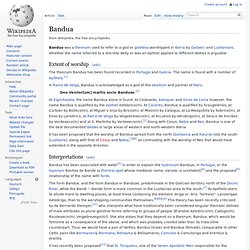
Whether the name referred to a discrete deity or was an epithet applied to different deities is arguable. Extent of worship[edit] In Rairiz de Veiga, Bandua is acknowledged as a god of the Vexillum and partner of Mars: Deo Vexilor[um] martis socio Banduae.[2] It has been proposed that the worship of Bandua spread from the north (Gallaecia and Asturia) into the south (Lusitania), along with that of Cosus and Nabia,[3][4] so contrasting with the worship of Reo that would have extended in the opposite direction. Interpretations[edit] Bangpūtys. This article is about the Lithuanian deity.

For the Lithuanian poet who used this name as one of his pen names, see Antanas Baranauskas. Bangpūtys is the name of a masculine deity [1] in Lithuanian mythology. Basing on very scanty sources, some mythologists have reconstructed him as a god of sea and storm. According to the reconstructions, he is austere and unrelenting. He has a beard, wings and two faces. Duberdicus. Durius. Durius or Durio was a god worshiped by the ancient Lusitanians and Celtiberians of the Iberian peninsula.
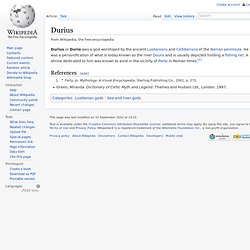
He was a personification of what is today known as the river Douro and is usually depicted holding a fishing net. A shrine dedicated to him was known to exist in the vicinity of Porto in Roman times.[1] Jump up ^ Forty, Jo. Mythology: A Visual Encyclopedia, Sterling Publishing Co., 2001, p. 272.Green, Miranda. Dictionary of Celtic Myth and Legend.
Iku-Turso. Description[edit] His appearance remains unclear, but he is described with several epithets: partalainen (the one who lives on the brink, or alternatively, the bearded one), Tuonen härkä (the ox of Tuoni, Death), tuhatpää (thousand-headed), tuhatsarvi (thousand-horned).
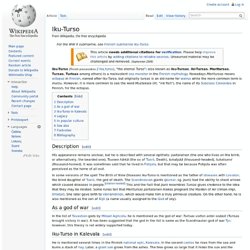
It was sometimes said that he lived in Pohjola, but that may be because Pohjola was often perceived as the home of all evil. Mímir. A 19th century depiction of Odin finding Mímir's beheaded body.

Nehalennia. Neck (water spirit) The Nyx/Nixie (German: Nix/Nixie/Nyx, Norwegian: Nøkk or plural: Nøkken) are shapeshifting water spirits who usually appear in human form.
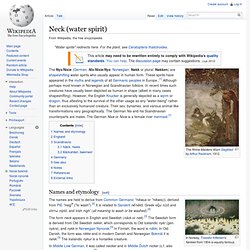
These spirits have appeared in the myths and legends of all Germanic peoples in Europe.,[1] Although perhaps most known in Norwegian and Scandinavian folklore. In recent times such creatures have usually been depicted as human in shape (albeit in many cases shapeshifting). However, the English Knucker is generally depicted as a wyrm or dragon, thus attesting to the survival of the other usage as any "water-being" rather than an exclusively humanoid creature.
Their sex, bynames, and various animal-like transformations vary geographically. The German Nix and his Scandinavian counterparts are males. The names are held to derive from Common Germanic *nikwus or *nikwis(i), derived from PIE *neigw ("to wash").[2] It is related to Sanskrit nḗnēkti, Greek νίζω nízō and νίπτω níptō, and Irish nigh' (all meaning to wash or be washed).[3]
Nerthus. Nerthus (1905) by Emil Doepler.

In Germania, Tacitus records that the remote Suebi tribes were united by their veneration of the goddess at his time of writing and maintained a sacred grove on an (unspecified) island and that a holy cart rests there draped with cloth, which only a priest may touch. Nine Daughters of Ægir. Ægir and his daughters brew ale in a large pot..
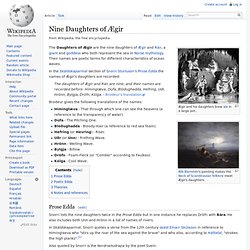
The Daughters of Ægir are the nine daughters of Ægir and Rán, a giant and goddess who both represent the sea in Norse mythology. Their names are poetic terms for different characteristics of ocean waves. In the Skáldskaparmál section of Snorri Sturluson's Prose Edda the names of Ægir's daughters are recorded: The daughters of Ægir and Rán are nine, and their names are recorded before: Himinglæva, Dúfa, Blódughadda, Hefring, Udr, Hrönn, Bylgja, Dröfn, Kólga. - Brodeur's translation Brodeur gives the following translations of the names: Himinglæva - That through which one can see the heavens (a reference to the transparency of water).Dúfa - The Pitching One.Blóðughadda - Bloody-Hair (a reference to red sea foam).Hefring (or Hevring) - Riser.Uðr (or Unn) - Frothing Wave.Hrönn - Welling Wave.Bylgja - Billow.Dröfn - Foam-Fleck (or "Comber" according to Faulkes).Kólga - Cool Wave.
Prose Edda[edit] Poetic Edda[edit] when Ægir's terrible daughter. Njörðr. Rán. In Norse mythology, Rán (Old Norse "sea" or "robber") is a sea goddess. According to Snorri Sturluson's Prose Edda book Skáldskaparmál, in his retelling of the Poetic Edda poem Lokasenna, she is married to Ægir and they have nine daughters together. Snorri also reports that she had a net in which she tried to capture men who ventured out on the sea: Ran is the name of Ægir's wife, and their daughters are nine, even as we have written before.
At this feast all things were self-served, both food and ale, and all implements needful to the feast. Then the Æsir became aware that Rán had that net wherein she was wont to catch all men who go upon the sea.[1] Her net is also mentioned in Reginsmál and in the Völsunga saga, where she lends it to Loki so that he can capture Andvari. Attestations[edit] "Ran" (1901) by Johannes Gehrts. Rusalka. In Slavic mythology, a rusalka (plural: rusalki or rusalky) is a female ghost, water nymph, succubus, or mermaid-like demon that dwelt in a waterway. Other terms for these spirits include vila (plural: vily), wiła, willy (plural: willies), samovila, samodiva, rusavka, and mavka. According to most traditions, the rusalki were fish-women, who lived at the bottom of rivers. In the middle of the night, they would walk out to the bank and dance in meadows. If they saw handsome men, they would fascinate them with songs and dancing, mesmerize them, then lead them away to the river floor to their death.
Ved-ava. Ved-ava is a water deity, common to several Baltic and Finno-Ugric peoples traditionally dependent on fishing. She is also sometimes associated with fertility. She is generally depicted as a water creature resembling a mermaid, with long hair, large breasts, and the lower body of a fish complete with tail, and is sometimes said to play or sing, seducing humans with her music. Fishermen sacrificed to her the first of their catch and observed numerous taboos related to her while fishing.
Seeing Ved-ava boded ill, most often drowning. She has been regarded as the spirit of a drowned person or simply as a personification of the water itself. Veles (god) Veles is one of few Slavic gods for which evidence of offerings can be found in all Slavic nations. Vellamo. Vodyanoy.